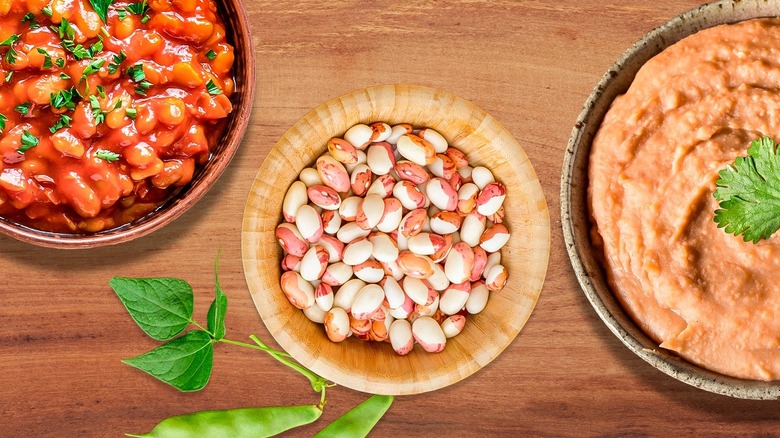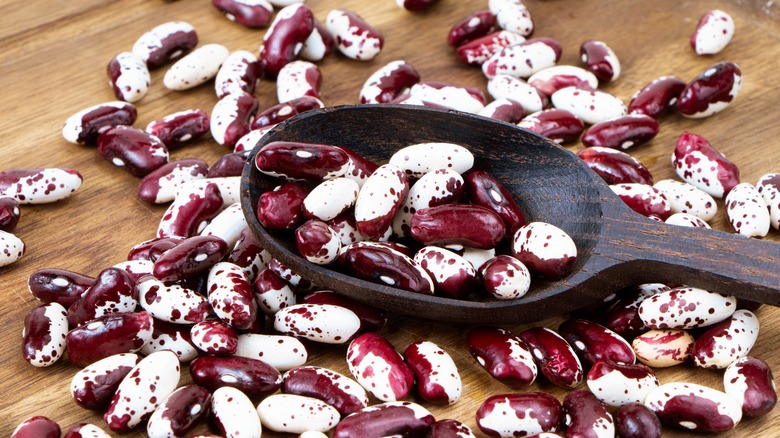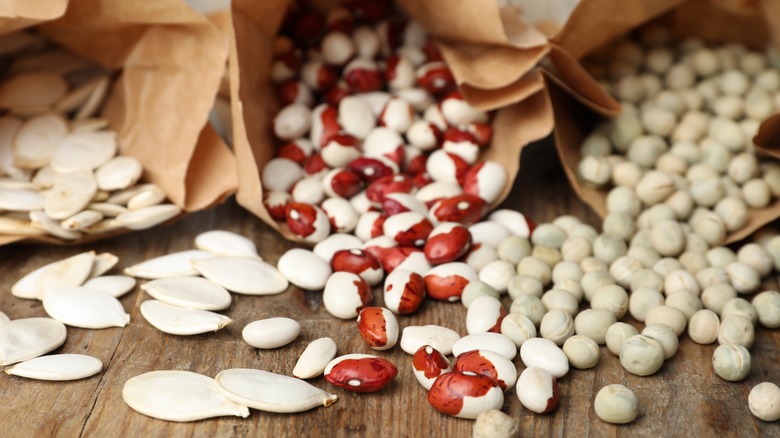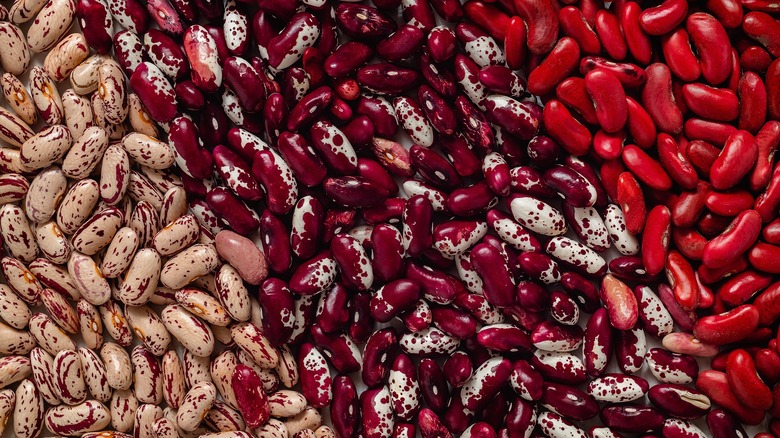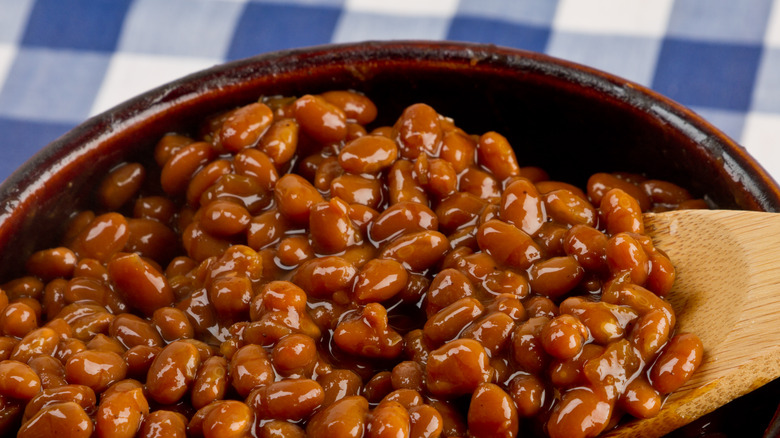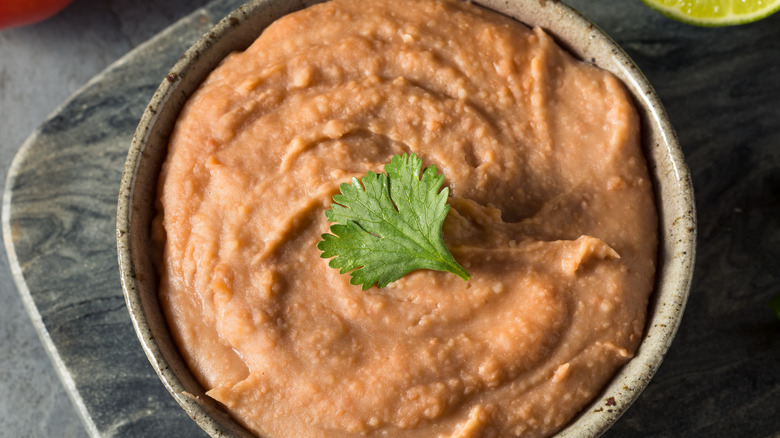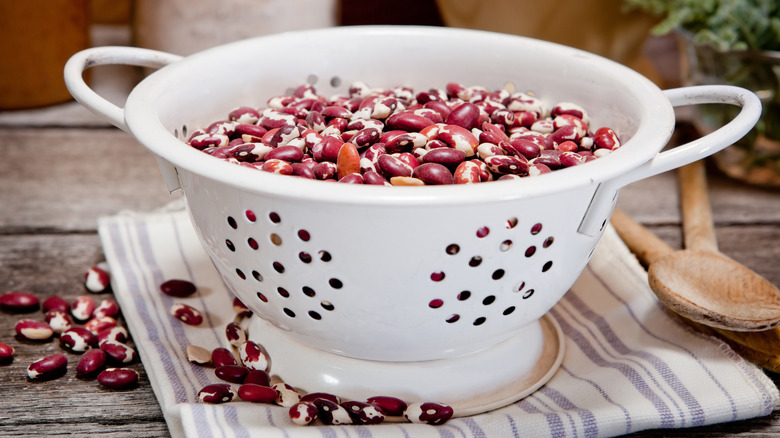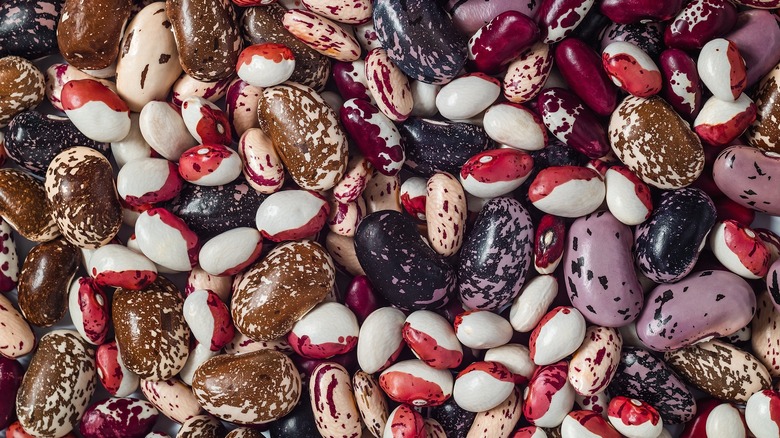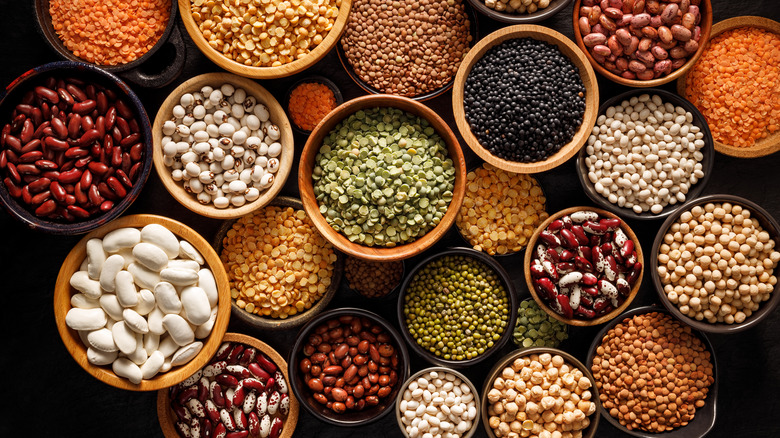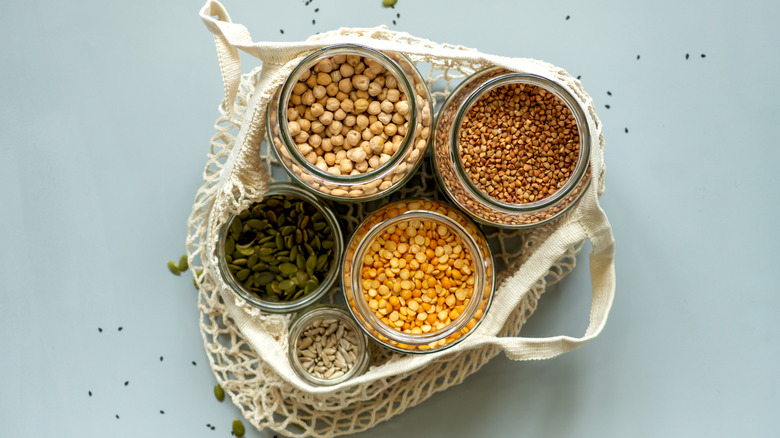What Are Anasazi Beans And What's The Best Way To Cook Them?
Oh, the humble bean. We love them for being an affordable, tasty vegetarian source of protein. If stored properly, they keep almost indefinitely, too. From simple uses for canned beans to slow-cooker recipes for the dried variety, to love a bean is to step into a world of culinary possibility not limited by budget or shelf life. There are over 40,000 documented varieties of beans, but perhaps the most fashionable within the expansive world of legumes are the heirlooms: Little nuggets of history that tell their own stories of trade, migration, and evolving culinary foodways. Some growers across the United States are recovering and planting exclusively heirloom varieties, leading to a veritable bean revival.
One such heirloom that has risen in popularity is the Anasazi bean — itself a kind of legume folklore that tells the tale of a civilization abandoned and a cuisine shunned. But what's the difference between the Anasazi bean and other more common (and strikingly similar) varieties of bean, like the pinto? How are heirlooms grown and where can you purchase them? And when it comes to practical matters of consumption, are they really worth the higher price tag?
What are Anasazi beans?
Anasazi beans are purple-and-white mottled heirloom shelling beans. They're members of the common bean family Phaseolus vulgaris — the same family that includes green beans, wax beans, and most other shelling beans. The bean was farmed in Mexico more than 7,000 years ago, allegedly one of the first crops to be cultivated in North America. As Colonialism took hold of the continent, Native American crops like the Anasazi bean were abandoned in favor of hybridized bean varieties cheaper to produce en masse.
According to the Albuquerque Journal, In the 1970's a farmer in Dove Creek, Colorado named Ernie Waller discovered the bean we now know of as Anasazi in a forgotten stockpile in his warehouse. Recognizing the commercial appeal of the bean's thin skin, vibrant color, and minimal oligosaccharide content (a gas-causing starch), Waller decided to trademark it. Around this time, heirloom varieties of corn, squash, and other traditional Native American foods were being overlooked by white farmers, and thus diners, in the United States. Waller dubbed the bean "Anasazi" as an homage to its Native cultivators and reseeded throughout the Southwest before eventually selling it through his business, Adobe Milling Company.
Who first cultivated the Anasazi bean?
Before becoming "Anasazi," this heirloom bean was simply a crop cultivated by an indigenous civilization that sprung up in the first century A.D. These people, called the Puebloans, ruled the American Southwest, or what was then considered the "Four Corners" of the United States — Utah, Colorado, Arizona, and New Mexico. They were given the name "Anasazi" by a neighboring Navajo tribe, which translates to "ancient enemies" or, more broadly, "those who are different than our people." The Anasazi bean was one of only a handful of crops they cultivated, having relied solely on hunting and gathering for their food supply up until 500 A.D.
Sometime around 1300 A.D., the Anasazi people fled their homeland, leaving their crops behind. The reason behind the fall of their civilization remains unclear, but many factors are suspected to have influenced their decision to leave — drought and conflict are the most likely causes. Because of the abrupt exit, it wouldn't be unlikely that they left their belongings in place with the hopes that one day they'd return; as one legend would have it, the Anasazi's now-namesake bean was left behind in a ceramic vessel sealed with pine tar to be discovered and cultivated centuries later.
The legend of the Anasazi bean
There is a lot of confusion — and lore — around the Anasazi beans' entry into the modern American diet. Some sources claim it was archaeologists who rediscovered the dried beans while excavating the ruins of Anasazi cave dwellings, sealed in their ancient vessels as if intended for later discovery.
According to reports from 5280 Magazine, the beans resurfaced in 1973 near the Lukachukai Mountains region of Northeastern Arizona when a woman named Bessie White was presented with a palmful of beans by her young student who had found them at a nearby Native American burial site. Back then, It was not uncommon for farm families in the Southwest to run into such ancient treasures when plowing their fields. White, an avid gardener, planted a few of the beans in her hometown, and to her delight, they germinated.
While both explanations of their origins make for a good story, it's most likely that the beans have always been spontaneously growing in the Four Corners, and that white settlers found them and began cultivating them across the region.
How do Anasazi beans grow?
Not all beans grow as swiftly or trellis as elegantly as Jack's magical beanstalk. Take the Anasazi for example, a bush bean that does not climb, but rather sprawls out across the topsoil. Anasazi beans prefer the full sun and well-drained soil of their native Southwest and take between 3-7 days to germinate. In three months' time, the beans will have reached full maturity, when they are plump enough to be harvested, hulled, and either dried for storage or cooked until creamy and tender. Shelling beans like these have pods that are too fibrous to be edible when mature, but if harvested young the seed pods can be cooked whole like you would a string bean.
Because the Anasazi is an heirloom, it's more resilient to drought than hybrid beans— good news if you're a gardener who tends to lapse on their watering duties (or if you happen to live in a space that doesn't have easy access to a hose hookup). If you're curious about cultivating this heirloom at home, look to Dove Creek's well-practiced farming community for cues: Many grow the beans with minimal irrigation, a method called "dry farming." Dry farming reduces a farm's water consumption, but it does slow the bean's growth considerably. Perhaps one reason why Anasazis and other heirlooms are not a common choice for commercial cultivation. However, dry farming can positively impact the taste of the bean by concentrating the mineral content, and thus the flavor (or terroir) the bean picks up from the soil.
How do you cook Anasazi beans?
Unlike other dried beans, Anasazis don't require advanced soaking. Dry farming has one other benefit beyond saving water: It keeps pests and diseases to a minimum, reducing farmers' reliance on fertilizer and yielding a thin-skinned bean that's perfect for quick cooking. The thinner skin also allows any seasonings added to the cooking water to penetrate the bean's starchy interior, flavoring the bean from within much in the same way that adding salt to a pot of boiling water for pasta seasons each noodle.
If you're short on active cooking time, however, soaking the beans ahead will expedite the process — taking around an hour's boil for the beans to yield until creamy. If you choose to skip the soak, the beans will cook up in a reasonable hour and a half instead. Be sure to keep an eye on the pot as they cook to ensure your water doesn't reach a rapid boil. The agitation can break apart the still-softening beans. And keep the lid cracked, too: Foods this starchy are inclined to bubble up and over-boil. Consider skimming any foam that rises to the surface of the water (totally natural) to preserve the purity of your eventual bean "consommé."
Anasazi beans lose their distinctive marbling and turn fully mauve when cooked through. The resulting broth, though delicious, will be similarly muted in color. But don't make the mistake of throwing away this flavorful cooking liquid: Bean "stock" makes an excellent substitute for vegetable or chicken broths and a tasty, nutrient-rich base for soups, stews — even pasta dishes like Italian minestra.
What dishes can you make with Anasazi beans?
Once your Anasazi beans are cooked through, you can treat them much in the same way as you would a pinto. With their Southwestern origins, Anasazi beans stand up well to the spicy flavors of Latin American and Southwestern cuisines. Seamlessly substitute Anasazi beans for any variety called for in refried bean, chili, and stew recipes. The shape, size, and color of Anasazi beans make them the ideal bean to use in any homemade baked bean recipe.
If refried beans are your thing, this pinto bean tostada recipe that uses puréed beans as a base can be made all the more delicious by substituting a high-quality heirloom bean like Anasazi for canned pintos. Since your beans will be cooked from dried, consider loosening up the eventual purée with a splash of bean cooking liquid during food processing. For a version of refried beans that skips the pre-cook entirely, dive straight into this creamy and versatile one-pot instant pot refried beans recipe from Melissa Olivieri of The Olive Blogger. It uses onion, garlic, cumin, and oregano to season the cooking liquid, resulting in a flavorful bean broth that's incorporated back into the beans once they're tender. The outcome is a creamier, more full-flavored bowl of refried beans than you'd get if you were to start the recipe by cracking open a can.
What do Anasazi beans taste like?
While you can love what an heirloom bean represents — a well-kept story and a more sustainable future — when it comes to paying a premium for a bean, it always comes down to taste. Says Steve Sando, CEO of Rancho Gordo, in The National Geographic, "People don't buy moral food in the end. You have to focus on flavor." Luckily, like other heritage bean varieties grown in the American Southwest the Anasazi bean is lauded for its velvety texture and near-nutty flavor, like that of a chestnut. The interior is creamy, lacking the gritty or toothsome characteristics often a problem in more commercially available beans.
In Dove Creek, where much of the Anasazi bean cultivation still takes place, farmers attribute the bean's good flavor to the high elevation at which they are grown, and the rust-red soil of the land, both of which impart the beans with a uniquely regional terroir. Unless you're a veritable bean connoisseur like Sando, you're unlikely to notice the difference between, say, a Jacob's Cattle and an Anasazi bean on the first bite. But give it time. The more beans you eat, the more you're likely to find a variety that suits your palate.
Where do you buy Anasazi beans?
Heirloom beans are popping up more and more in grocery stores: Whole Foods now carries Rancho Gordo's Midnight Black and Cranberry beans online. But are Anasazi beans too niche to find through a mainstream retailer? A quick search for 'Anasazi bean near me' pulls up Adobe Milling's beans, as well as Anasazi beans distributed by Woodland Foods and Pepper Creek Farms, all available at Walmart.
To guarantee sourcing your best bet is to purchase them directly through Adobe Milling Co. Keep in mind that Anasazi beans will cost significantly more than common commercially available varieties like pinto, kidney, and navy beans. Wherever you choose to buy your beans, make sure they're fresh by giving 'em a sniff before going to the trouble of cooking them. If they smell bitter, like old walnuts, then they've gone rancid and should be tossed. Once you're ready to start cooking, cover the beans with water and remove any particulate matter –sand, small stones, even bruised beans — that float to the surface and you're off to the races.
What are the best substitutes for Anasazi beans?
If you can't get your hands on a pound of Anasazi beans, or you don't feel like making a special purchase online, you can easily substitute them with pinto beans. Any small to medium-sized pink bean in the common bean family Phaseolus vulgaris will work well in a pinch. Vaquero (another name for the Anasazi bean), cranberry, or borlotti beans are also good substitutes, with strong, beanie flavor and a creamy texture.
While still delicious, beans like the kidney and the pinto have lost some of their distinctive characteristics through species selection and processing. If you're looking for another heirloom bean to try that performs similarly to the Anasazi bean, why not try the Jacob's Cattle? Jacob's Cattle beans were once one of the most common shelling bean varieties grown in North America, eventually falling into obscurity with the advent of crop modern-day farming practices like cross-breeding and hybridization. They've since returned, however, to the modern American pantries. (You can thank heirloom bean evangelists for that). The Jacob's Cattle bean is best thought of as a cousin to the Anasazi, making it a good choice if you're looking for a bean substitute that doesn't skimp on flavor or velvety texture.
Nutritional information on Anasazi beans
Aside from being a relatively mild-mannered ingredient to work with, there's another reason why you may still be bean-avoidant: the gas they may produce in the uninitiated stomach. (The cure for bean-induced gastric troubles? According to the Bean Institute, eating more beans.) If you're particularly sensitive to beans (or particularly bashful about gas), give Anasazis a try: They contain only 75% of the oligosaccharides that are found in more popular bean varieties. Oligosaccharides are gas-causing starches prolific in alliums, cruciferous vegetables, and especially — beans. When oligosaccharides find their way into the large intestine, they ferment, releasing gas. This is a good thing, as the gas signifies that the starch in the beans is acting as a prebiotic, feeding the good bacteria present in your gut.
The Phaseolus family of beans has also been shown to reduce cholesterol in the body, among other positive health benefits. Anasazi beans are rich in fiber, which also aids in digestion and they can decrease inflammation in the body. Anasazi beans are high in magnesium, potassium, calcium, and other minerals. They also contain lectins, anti-mutagenic compounds that, when isolated, have been proven to decrease the risk of some cancers and reduce how quickly they spread.
How to store Anasazi beans
Dried beans, like grains and other store crops intended to last throughout the winter, prefer a cool, dry environment with limited exposure to oxygen and light. Though low in fat, beans still contain small amounts of naturally-occurring oils. Heat and air are common enemies to beans, causing these oils to turn rancid. If you're planning on using dried Anasazi beans within a few weeks, storing them in your pantry should sufficiently guard against spoilage — unless you live in a hot or moist environment. Otherwise, consider vacuum-sealing the beans, or placing them in an airtight container or latch-top canister to prevent oxygen from reaching them. If you live in a warm climate, consider keeping beans in your fridge or freezer instead.
If you are planning on cooking dried beans that have been stored longer than one year, add 1/4 teaspoon of baking soda for each pound of beans to the cooking water to help them soften during cooking. Baking soda contains sodium, which weakens pectin, a compound that strengthens the beans' cell walls. The formation of pectin chains creates a skin that's difficult to soften during cooking and is, therefore, less elastic when the beans require this the most resulting in burst beans. An alkaline environment, like the one created by adding baking soda to water, has the added benefit of speeding up cooking by as much as 50%.
